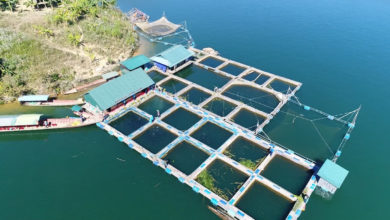Bạc Liêu: Finalize the infrastructure of hi-tech shrimp farming
Bạc Liêu is developing various high technology based models of shrimp farming and becoming a pioneer in this field all over the country.
Bạc Liêu is developing various high technology based models of shrimp farming. In 2015, the province started to apply high technologies in over 70ha of shrimp farms which then increased to more than 2,250ha in 2020. By 2021, the province had 23 companies and 650 households related to shrimp farming, with more than 3,730 ha of land being used and over 72,960 tons of shrimps being produced. The hi-tech based shrimp farming model produces an output of shrimp which is ten or fifteen times as much as the traditional model.
Director of Long Mạnh company in Vĩnh Hậu A commune of Hoà Bình district said that the company has applied a three-phase superintensive technology in white leg shrimp farming in circular ponds. The technique of extraction of solid disposals and water reuse have been applied. This has been evaluated as the most updated hi-tech based shrimp farming model so far. The company builds 20 floating round tanks, 500-800m2 each, from round steel frames, liners, and a Biofloc based wastewater treatment system.
The province has finalized the first phase of the infrastructure of the project “The high technology based agricultural area for shrimp development in Bạc Liêu” funded with VND 176 billion. The project is about to go to the second phase and another project, namely “Develop Bạc Liêu to become a shrimp center of Vietnam”, is performed.
Nine companies are selected as investors of the hi-tech based agricultural area for shrimp development in Bạc Liêu and seven units are granted international certificates for aquaculture.
Bạc Liêu’s competent authorities said that the province would focus on developing the hi-tech based shrimp farming model. The project “Develop Bạc Liêu to become a shrimp center of Vietnam” will be promoted and the hi-tech based agriculture will be developed in a sustainable direction and for adaptation to climate change.
The province plans to spend 26,300 ha of land on the intensive and super-intensive shrimp farming with an expected output of 76,400 tons, and sets a target of achieving a worth of USD 1 billion from seafood exports in the near future.
VFM






